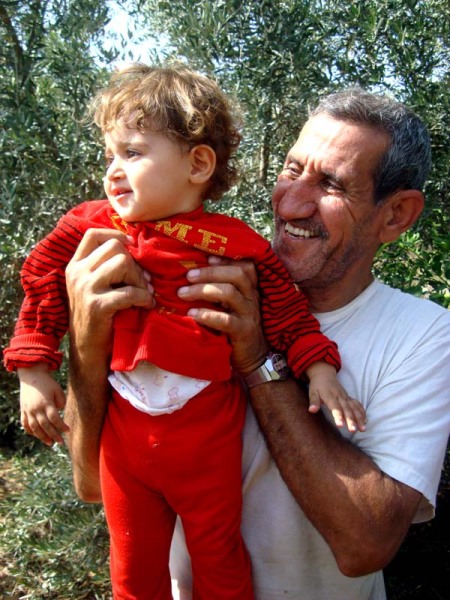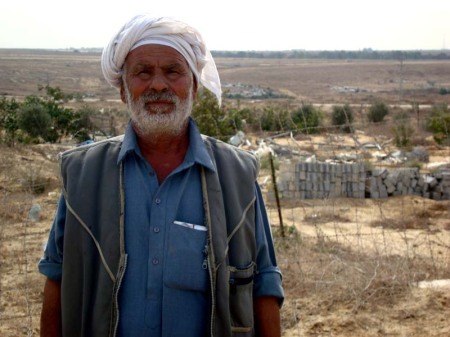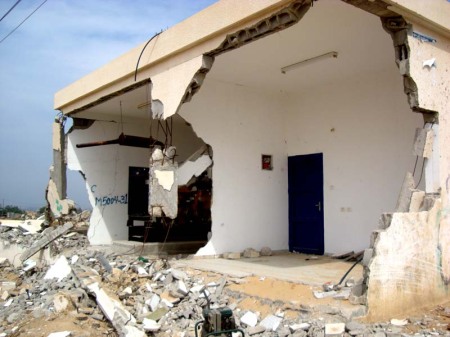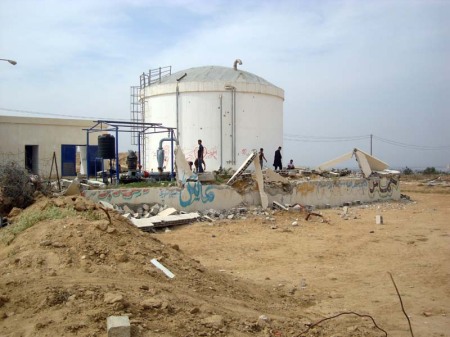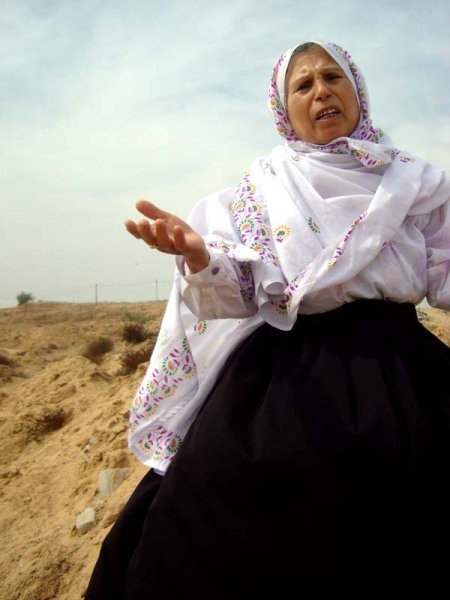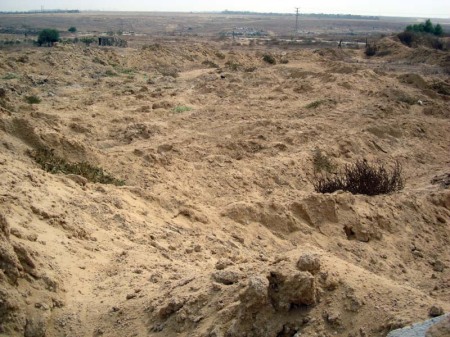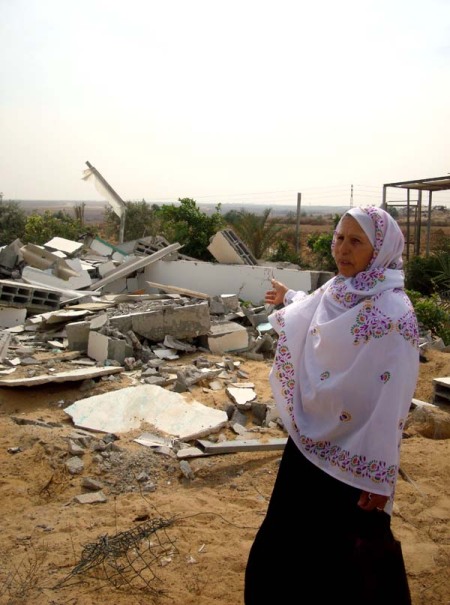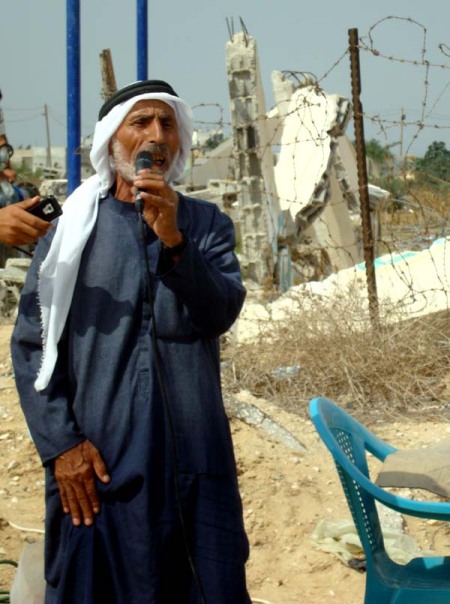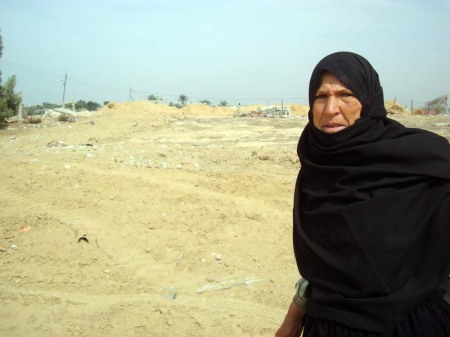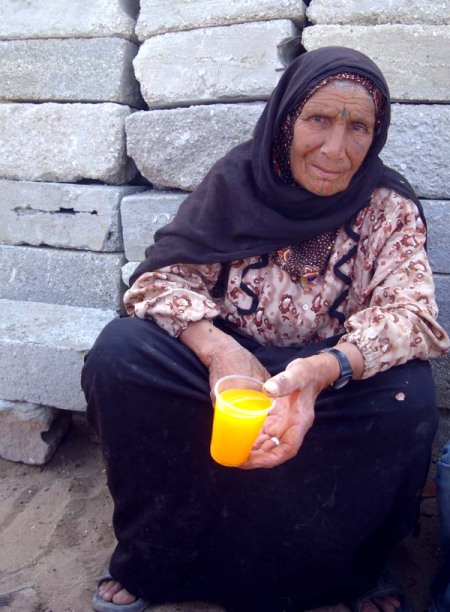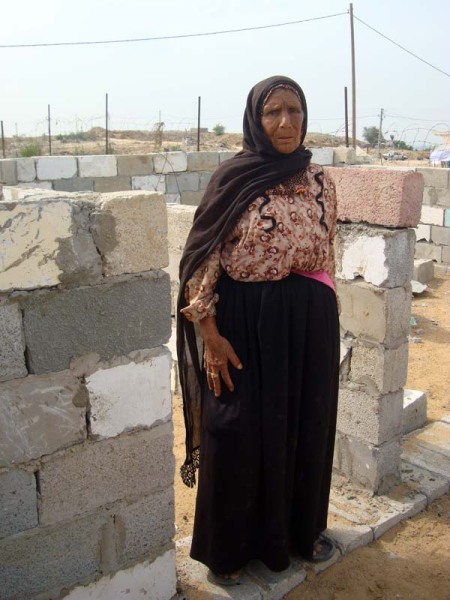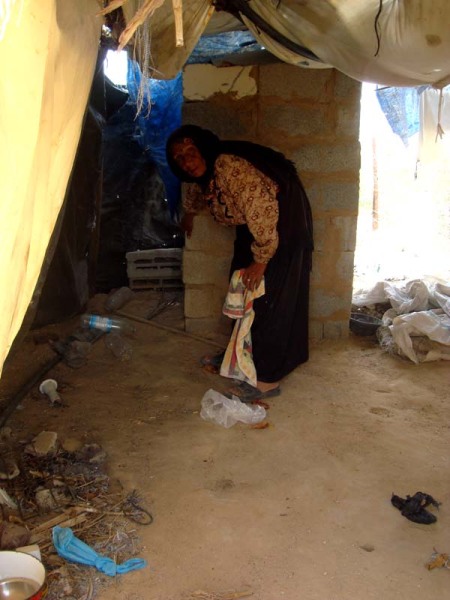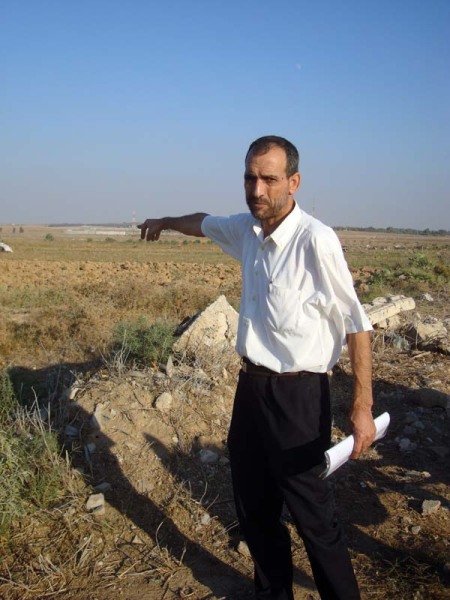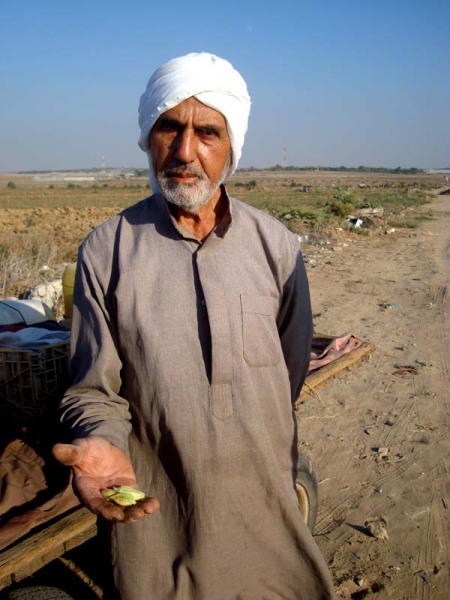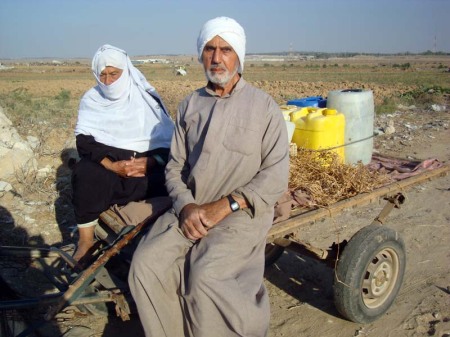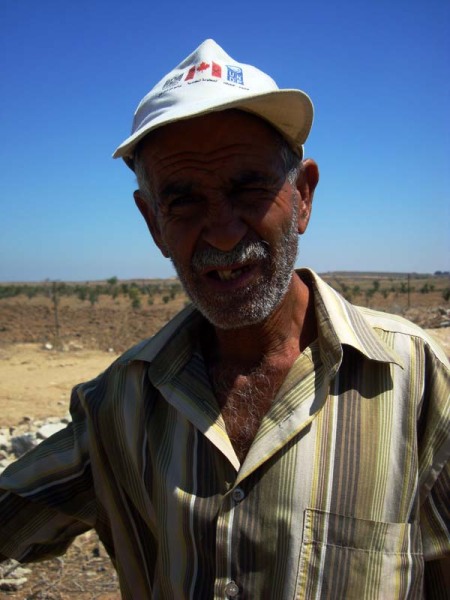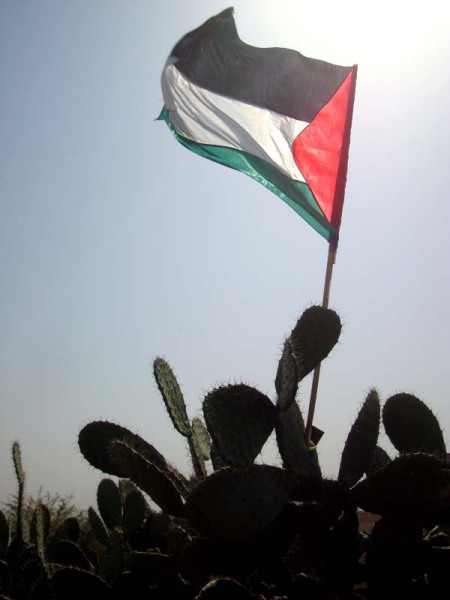October 19, 2009
Israeli Arab backlash over covert police unit
NAZARETH, ISRAEL - Civil rights groups in Israel have expressed outrage at the announcement last week that a special undercover unit of the police has been infiltrating and collecting intelligence on Israel’s Arab minority by disguising its officers as Arabs.
It is the first public admission that the Israeli police are using methods against the country’s 1.3 million Arab citizens that were adopted long ago in the occupied territories, where soldiers were regularly sent on missions disguised as Palestinians.
According to David Cohen, the national police commissioner, the unit was established two years ago after an assessment that there was “no intelligence infrastructure to deal with the Arab community”. Mr Cohen said that, in addition, undercover agents had been operating in East Jerusalem for several years to track potential terrorists.
Israel’s Arab leaders denounced the move as confirmation that the Arab minority was still regarded by the police as “an enemy” – a criticism made by a state commission of inquiry after police shot dead 13 unarmed Arab demonstrators inside Israel and wounded hundreds more at the start of the second intifada in 2000.
In a letter of protest to Israeli officials last week, Adalah, a legal rights group, warned that the unit’s creation violated the constitutional rights of the Arab minority and risked introducing “racial profiling” into Israeli policing.
Although the police claim that only Arab criminals are being targeted, Arab leaders believe the unit is an expansion of police efforts to collect information on political activists, escalating what they call a “climate of fear” being fostered by the government of Benjamin Netanyahu, the prime minister.
Awad Abdel Fattah, the general secretary of the National Democratic Assembly, whose members are regularly interrogated by the police even though the party is represented in the national parliament, said there was strong evidence that undercover units had been operating in Arab communities for many years.
“The question is, why are the police revealing this information now? I suspect it is designed to intimidate people, making them fear that they are being secretly watched so that they don’t participate in demonstrations or get involved in politics. It harms the democratic process.”
Secret agents disguised as Arabs – known in Hebrew as “mista’aravim” – were used before Israel’s founding. Jews, usually recruited from Arab countries, went undercover in neighbouring states to collect intelligence.
The Haaretz newspaper revealed in 1998 that the secret police, the Shin Bet, also operated a number of mista’aravim inside Israel shortly after the state’s creation, locating them in major Arab communities.
The unit was disbanded in 1959, amid great secrecy, after several agents married local Arab women, and in some cases had children with them to maintain their cover.
But the mista’aravim are better known for their use by the Israeli army on short-term missions inside Arab countries or in the West Bank and Gaza Strip, where they have often been sent to capture or kill local leaders.
Famously, Ehud Barak, the current defence minister, was sent to Beirut in 1973 disguised as an Arab woman to assassinate three Palestinian leaders.
More recently, however, the army’s mista’aravim have come to notice because of allegations that they are being used as agents provocateurs, especially in breaking up peaceful protests by Palestinians in the West Bank against the separation wall.
In April 2005, during a demonstration at the village of Bilin, north of Jerusalem, Palestinians throwing stones at soldiers were revealed to be mista’aravim. They were filmed blowing their cover shortly afterwards by pulling out pistols to make arrests. The army later admitted it had used mista’aravim at the demonstration.
Palestinians claim that stone-throwing by mista’aravim is often used to disrupt or discredit peaceful demonstrations and justify the army’s use of rubber bullets and live ammunition against the protesters in retaliation.
Last week, Jamal Zahalka, an Arab member of parliament, warned other legislators that mista’aravim police officers would adopt similar tactics: “Such a unit will carry out provocations, in which the Arab public will be blamed for disorderly conduct.”
Mr Abdel Fattah said there were widespread suspicions that mista’aravim officers had been operating for years at legal demonstrations held by Israel’s Arab citizens, including at the protests against Israel’s winter attack on Gaza.
He said they were often disguised as journalists so that they could photograph demonstrators.
A female activist from his party had been called in by the police for interrogation after a demonstration last year in the Arab town of Arrabeh, he said. “The officer told her, ‘I know what you were saying because I was standing right next to you’. And he then told her exactly what she had said.”
In his testimony to a government watchdog, the police commissioner, Insp Gen Cohen, said he had plans for the unit “to grow” and that it would solve a problem the police had in infiltrating Israel’s large Arab communities: “It’s very hard for us to work in Umm al-Fahm, it’s very hard for us to deal with crime in Juarish and Ramle.”
Several unnamed senior officers, however, defended their role in monitoring the Arab community, claiming the commissioner was wrong in stating that the use of mista’aravim inside Israel was new. One told Haaretz: “Existing units of mista’aravim have operated undercover among this population for about a decade.”
Orna Cohen, a lawyer with the Adalah legal group, said the accepted practice for police forces was to create specialised units according to the nature of the crime committed, not according to the ethnicity or nationality of the suspect.
She warned that the unit’s secretive nature, its working methods and the apparent lack of safeguards led to a strong suspicion that the Arab minority was being characterised as a “suspect group”. “Such a trend towards racial profiling and further discrimination against the minority is extremely dangerous,” she said.
Comments two years ago from Yuval Diskin, the head of the Shin Bet, have raised fears about how the police unit may be used. He said the security services had the right to use any means to “thwart” action, even democratic activity, by the Arab minority to reform Israel’s political system. All the Arab parties are committed to changing Israel’s status from a Jewish state to “a state of all its citizens”.
Mr Abdel Fattah said: “This is about transferring the methods used in the West Bank and Gaza into Israel to erode our rights as citizens. It raises questions about what future the state sees for us here.”
Source
Olive Harvest: notes from the field

- Issam Shedahah with the remains of his car
- Photo by Lazar Simeonov
Issam Shedahah, 39, is a long time resident of Burin and it has cost him dear. We are looking at the burnt out husk of his car, torched the previous night by the settlers of Itzhar. “This is the fourth time they have burnt my car”, he tells us, “now it is very common that they come into the village at night”. Neither does Issam’s suffering end with material damage. Another recent settler invasion resulted in the murder of his brother. “He was sitting on the roof one evening, not doing anything. They shot him in the head.”
He indicates the roof of the shop/apartment the family own. It is directly across the street from the remains of his car. “Last night I woke up at 3am and I heard voices. I looked out the window and I saw them breaking the windows and throwing Benzene all over the seats, then they set fire to it and walked away.” Issam explains that the people of Burin are used to having their farms attacked, he points up to ‘black mountain’, where all the once-green trees have been reduced to charcoal. But the recent tendency of settlers to enter the village, with full knowledge of Israeli Army soldiers, is making life unbearable. “All the time we are attacked by settlers. They have taken my grandfather’s land; they want to steal all of our land. All the time we are suffering”.
Neighbours inform us that several more cars have been burnt recently. We can see that nearby houses also bear the scars of settler attacks. Huwara Mayor Samer Odeh has condemned what he called “continuous settler attacks”, while Union leaders tell us that 5,000 PA security troops have been assigned to protect the farmers. For Issam Shedaheh and the people of Burin, no protection exists. Just the daily horrors of a life under siege.
Israel kidnaps Palestinian journalist in Al-Khalil
October 19, 2009
AL-KHALIL, Israeli occupation forces (IOF) kidnapped Palestinian journalist Iyad Sorour from Al-Khalil city, in the south of the West Bank on Sunday, only one month after his release from the Palestinian Authority’s jails.
The forum of Palestinian journalists said in a press release that a large number of IOF troops stormed the house of Sorour in the city and took him to an unknown destination.
The forum affirmed that Sorour spent 10 months in the PA intelligence’s jail and was released a month ago, adding that he was detained for 14 months in Israeli jails in 2002.
The forum appealed to the international federation of journalists, the organization of reporters without borders and the union of Arab journalists to intervene and pressure Israel to immediately release all journalists in its jails.
It also called on Mahmoud Abbas to instruct his militias in the West Bank to release journalists detained in his jails and end restrictions imposed on their freedom.
Nine other Palestinian citizens have also been kidnapped at dawn Monday during raids carried out by IOF troops on homes in different West Bank areas.
The lawyer of the Palestinian prisoners' society also reported Sunday that the Ofer prison administration imposed a number of punitive measures on Palestinian prisoners in section nine under the pretext of tampering with the section’s door lock, the allegation was denied by prisoners.
The lawyer added that the prison administration deprived prisoners of visits and the canteen for one month and a half as of 18 October.
He also said that the prisoners complained about the Red Cross’s neglect of their needs, saying that they did not receive yet what they asked the Red Cross representatives to bring with them, including books and clothes, because they had not visited the prison for four months.
Source
October 18, 2009
Dignified beyond losses
*Mahmoud Musleh: “I’ve had three main things destroyed by Israeli forces: a tile factory on Sikka street (northern Beit Hanoun), another tile factory on Salah el Din street (Beit Hanoun), and the water well on my land. My olive trees have been bulldozed many times by Israeli forces. I’m 70 years old and now I have nothing, like when I was 16.”
*Mohammed Zaneen [eastern Beit Hanoun]: “I had 11 dunams of olive trees, bulldozed by the Israeli army. I used to earn well over US$11,000 from the olives. Now my oldest trees are just 4 years old and produce only a meagre amount. We also have bees. When there were many olive, lemon and orange trees, the bees produced quality honey twice per year. Now, we have to supplement the bees’ diet with sugar; they produce honey just once per year.”
*Abdullah Abu Shar, Waddi Salqa (central eastern Gaza): “During the Israeli war on Gaza, my house and 50 other homes from our extended family were destroyed by the Israeli army. My son Mahmoud (25) and his wife Fida (18) were killed with their son Tamer (10 months) by two Israeli drone missile attacks on their home.” [He later adds, "we have 4 martyrs in our family, bas (only)." "That's too many," I say. His stoic face crumbles and he sobs silently for a moment.]
*the water tank and pump, sending water to 150,000 residents, was destroyed in the Israeli attacks. It was out of use for 2 months. It has been re-built 4 times over the last 10 years.
*Masiouna Abu Shar: “I lived here for 50 years. This was my grandfather’s land. The Israelis destroyed everything. Not a single house was left. All the land destroyed. All of us now have to rent homes in Deir el Balah. $150 per month. The land is so torn up you can’t farm it any longer. What can we do with this land?”
“This was our house. Nothing is left. We had 50 trees, too: olives, figs, guava… all destroyed. See those houses over there? Destroyed, everything gone, all from our family.”
*Abdul-Raziq Abu Shar: “Three times the Israelis have bulldozed my olive trees in the last 7 years: in 2002, 2004, and 2005. I had 120 olive trees, and another 100 date trees. 15 of which were over 30 years old.”
“Thank you very much, thank you for listening.”
*Nayfa Abu Shar: “My house was destroyed, along with all my trees.”
*Ghrelli Abu Shar: “I lived with my son and his 4 children. Our house was destroyed. So were our 80 trees: we had figs, olives, lemons and dates.”
“We’ve made a small two room shelter with some of the stones we retrieved, but it’s not complete. When I come here during the day, I use this tent for shade, make food over a fire. I’m afraid to stay past sunset; the Israeli soldiers are always shooting at us here.”
*Sabri Jendiya (74), Shayjayee, eastern Gaza: “I’ve worked our land since I was a boy. We’re farmers, we put all of our investment into our land. We have 30 dunams (30,000 square metres) about 800m from the border fence.Because of the danger from Israeli soldier shooting, I don’t work my land like I used. Also, all the water sources were destroyed by the Israeli war on Gaza. When it rains, I will plant simple vegetables. There are 30 people in our house and only one of my sons has work.”
*Shabaan Mohammed Mhayssy (83): “I was so happy on my 7.5 dunams of land. I spent 10,000 shekels (~$2,500) to make our water cistern with a pump for watering the land. My olive trees were very old. The cistern and all of my trees have been destroyed by Israeli soldiers. I can’t feed the 30 people in our house.”
*Samir: “My land has been bulldozed 7 times. This area had maybe 100 olive and orange trees. There were 6 wells. All have been destroyed. When farmers were producing their own food, they were able to live self-sufficiently. Now they are run-off their land by Israeli attacks and are dependent on aid.”
*Ramzi Hillis: “I have good land, 20 dunams (20,000 square metres) about 400m from the border fence. All the trees and my 10,000 chickens have been bulldozed and destroyed, from 2004 until now. We still keep bees, though the honey production is very poor these years. I work as a taxi driver now to help support the 13 people in my family.”
*Amar Mhayssy (78): “My wife and I have 9 dunams (9,000 square metres) of land in the buffer zone. We can’t use the land because the Israelis will shoot us. We have 10 dunams of land over 500m from the border fence. Of that, we had 2 dunams of olive trees, over 60 years old. They were all bulldozed by the Israeli army. We will re-plant, and pray to Allah that the trees are not again bulldozed. We’ve got 13 people in our family, with 4 children in university. None of us has employment.”
*Amar Mhayssy and Sena Mhayssy (75): “Every morning the Israeli soldiers shoot at us. It’s a hard life here.”
*Salem As Saede. eastern Beit Hanoun: “I had 4.5 dunams of land, with olive and orange trees; it has all been destroyed by Israeli soldiers in recent years” During the winter Israeli massacre of Gaza, Israeli soldiers finished off his land and once again destroyed his water well. Married twice, Saede has 17 children, non employed. All are dependent on food aid. He cannot even work his land to provide fresh produce. Formerly, Saede was a school teacher.
October 17, 2009
Jerusalem Crimes Derail Lieberman Tour
By Kawther Salam - Vienna, Austria - October 17, 2009
During a recent press conference, Austrian Foreign Minister Dr. Michael Spindelegger called for a stop of construction of Jewish squatter colonies in the West Bank and East Jerusalem, for a removal of the outposts emplaced since 2001, and for an end of the Israeli “blockade policy”, stressing that “a peace process in the Middle East that deserves this name would be in Israel’s very own interest”. Minister Spindelegger gave this press conference on 14 October 2009, at the end of a visit by israeli foreign minister Liebermann in Austria. The visit had previously been announced by Liebermann, implying that Austria, among other countries, “had not yet received his attention”, as if his dropping by was a great favor to these countries. The full text of the press release of the Austrian foreign ministry follows (emphasis mine):
“There will be no success overnight in the Middle East. Yet we must exploit every opportunity for movement”, said Foreign Minister Michael Spindelegger after his meeting with Israeli Foreign Minister Avigdor Liberman in Vienna. “A peace process in the Middle East that deserves this name would be in Israel’s very own interest. The development of Israeli relations with Egypt and Jordan in recent decades shows that sustainable peace results in a concrete security gain for Israel”, stressed Spindelegger.
“No partner in the region can evade its responsibility”. Everyone must make their contribution toward creating an atmosphere that allows for serious negotiations”, said the Minister, who also described the clear expectations toward Israel: “We demand a credible stop to the illegal settlement policy, even in Eastern Jerusalem, and the dismantling of the outer posts that have been illegally erected since 2001. Likewise, Israel should put an end to the humanitarian suffering in the Gaza Strip and lift the suffocating blockade policy.”
At the same time, Palestinians must also make their contribution. “A lasting internal Palestinian reconciliation, a convincing rejection of violence, and the recognition of Israel’s right to exist are indispensable concessions for realizing the vision of an own state for the Palestinian people”, said Spindelegger.
The two Ministers also discussed the Goldstone report on the Gaza conflict in the beginning of the year. “The report, which is to be further debated by the UN Human Rights Council, contains serious accusations against both conflict parties. It should form the basis for Israel and the Palestinians to carry out comprehensive internal examinations into the accusations. The objective is also to build up mutual trust. There can be no blank spots on the map of humanitarian international law in the Middle East”, stressed Spindelegger.
Source (Austrian Foreign Ministry).
Statement against impending military offensive by Indian govt in indigenous people’s areas
Sanhati, a collective of activists/academics who have been working in solidarity with peoples’ movements in India by providing information and analysis, took the initiative to bring together voices from around the world against the Government of India’s planned military offensive in Central India. A statement and a background note were drafted in consultation with Indian activists, and duly circulated for endorsement - several eminent intellectuals/academics along with hundreds of others from across the world have endorsed. Attached to the statement and signatories, is a background note providing the political perspective of this conflict.
To Dr. Manmohan Singh Prime Minister, Government of India, South Block, Raisina Hill, New Delhi, India-110 011.
We are deeply concerned by the Indian government’s plans for launching an unprecedented military offensive by army and paramilitary forces in the adivasi (indigenous people)-populated regions of Andhra Pradesh, Chattisgarh, Jharkhand, Maharashtra, Orissa and West Bengal states. The stated objective of the offensive is to "liberate" these areas from the influence of Maoist rebels. Such a military campaign will endanger the lives and livelihoods of millions of the poorest people living in those areas, resulting in massive displacement, destitution and human rights violation of ordinary citizens. To hunt down the poorest of Indian citizens in the name of trying to curb the shadow of an insurgency is both counter-productive and vicious. The ongoing campaigns by paramilitary forces, buttressed by anti-rebel militias, organised and funded by government agencies, have already created a civil war like situation in some parts of Chattisgarh and West Bengal, with hundreds killed and thousands displaced. The proposed armed offensive will not only aggravate the poverty, hunger, humiliation and insecurity of the adivasi people, but also spread it over a larger region.
Grinding poverty and abysmal living conditions that has been the lot of India’s adivasi population has been complemented by increasing state violence since the neoliberal turn in the policy framework of the Indian state in the early 1990s. Whatever little access the poor had to forests, land, rivers, common pastures, village tanks and other common property resources has come under increasing attack by the Indian state in the guise of Special Economic Zones (SEZs) and other "development" projects related to mining, industrial development, Information Technology parks, etc. The geographical terrain, where the government’s military offensive is planned to be carried out, is very rich in natural resources like minerals, forest wealth and water, and has been the target of large scale appropriation by several corporations. The desperate resistance of the local indigenous people against their displacement and dispossession has in many cases prevented the government-backed corporations from making inroads into these areas. We fear that the government’s offensive is also an attempt to crush such popular resistances in order to facilitate the entry and operation of these corporations and to pave the way for unbridled exploitation of the natural resources and the people of these regions. It is the widening levels of disparity and the continuing problems of social deprivation and structural violence, and the state repression on the non-violent resistance of the poor and marginalized against their dispossession, which gives rise to social anger and unrest and takes the form of political violence by the poor. Instead of addressing the source of the problem, the Indian state has decided to launch a military offensive to deal with this problem: kill the poor and not the poverty, seems to be the implicit slogan of the Indian government.
We feel that it would deliver a crippling blow to Indian democracy if the government tries to subjugate its own people militarily without addressing their grievances. Even as the short-term military success of such a venture is very doubtful, enormous misery for the common people is not in doubt, as has been witnessed in the case of numerous insurgent movements in the world. We urge the Indian government to immediately withdraw the armed forces and stop all plans for carrying out such military operations that has the potential for triggering a civil war which will inflict widespread misery on the poorest and most vulnerable section of the Indian population and clear the way for the plundering of their resources by corporations. We call upon all democratic-minded people to join us in this appeal.
National Signatories
![]() Arundhati Roy, Author and Activist, India
Arundhati Roy, Author and Activist, India![]() Amit Bhaduri, Professor Emeritus, Center for Economic Studies and Planning, JNU, India
Amit Bhaduri, Professor Emeritus, Center for Economic Studies and Planning, JNU, India![]() Sandeep Pandey, Social Activist, N.A.P.M., India
Sandeep Pandey, Social Activist, N.A.P.M., India![]() Manoranjan Mohanty,Professor of Social Development, Council for Social Development, India
Manoranjan Mohanty,Professor of Social Development, Council for Social Development, India![]() Prashant Bhushan, Supreme Court Advocate, India
Prashant Bhushan, Supreme Court Advocate, India![]() Nandini Sundar, Professor of Sociology, Delhi School of Economics,University of Delhi, India
Nandini Sundar, Professor of Sociology, Delhi School of Economics,University of Delhi, India![]() Colin Gonzalves, Supreme Court Advocate, India
Colin Gonzalves, Supreme Court Advocate, India![]() Arvind Kejriwal, Social Activist, India
Arvind Kejriwal, Social Activist, India![]() Arundhati Dhuru, Activist, N.A.P.M., India
Arundhati Dhuru, Activist, N.A.P.M., India![]() Swapna Banerjee-Guha, Department of Geography, University of Mumbai, India
Swapna Banerjee-Guha, Department of Geography, University of Mumbai, India![]() Anand Patwardhan, Film Maker, India
Anand Patwardhan, Film Maker, India![]() Dipankar Bhattachararya, General Secretary, Communist Party of India(Marxist-Leninist) Liberation, India
Dipankar Bhattachararya, General Secretary, Communist Party of India(Marxist-Leninist) Liberation, India![]() Bernard D’Mello, Associate Editor, Economic and Political Weekly (EPW), India
Bernard D’Mello, Associate Editor, Economic and Political Weekly (EPW), India![]() Sumit Sarkar, Retired Professor of History, Delhi University, India
Sumit Sarkar, Retired Professor of History, Delhi University, India![]() Tanika Sarkar, Professor of History, J.N.U., India
Tanika Sarkar, Professor of History, J.N.U., India![]() Gautam Navlakha, Consulting Editor, Economic and Political Weekly, India
Gautam Navlakha, Consulting Editor, Economic and Political Weekly, India![]() Madhu Bhaduri, Ex-ambassador
Madhu Bhaduri, Ex-ambassador![]() Sumanta Banerjee, Writer, India
Sumanta Banerjee, Writer, India![]() Dr. Vandana Shiva, Philosopher, Writer, Environmental Activist, India
Dr. Vandana Shiva, Philosopher, Writer, Environmental Activist, India![]() M.V. Ramana, Program on Science and Global Security,Princeton University, USA
M.V. Ramana, Program on Science and Global Security,Princeton University, USA
BACKGROUND NOTE
It has been widely reported in the press that the Indian government is planning an unprecedented military offensive against alleged Maoist rebels, using paramilitary and counter-insurgency forces, possibly the Indian Armed Forces and even the Indian Air Force. This military operation is going to be carried out in the forested and semi-forested rural areas of the states of Andhra Pradesh, Chhattisgarh, Jharkhand,West Bengal and Maharashtra, populated mainly by the tribal (indigenous) people of India. Reportedly, the offensive has been planned in consultation with US counter-insurgency agencies. To put the Indian government’s proposed military offensive in proper perspective one needs to understand the economic, social and political background to the conflict. In particular, there are three dimensions of the crisis that needs to be emphasized, because it is often overlooked: (a) the development failure of the post-colonial Indian state, (b) the continued existence and often exacerbation of the structural violence faced by the poor and marginalized, and (c) the full-scale assault on the meager resource base of the peasantry and the tribal (indigenous people) in the name of “development”. Let us look at each of these in turn, but before we do so it needs to be stressed that the facts we mention below are not novel; they are well-known if only conveniently forgotten. Most of these facts were pointed out by the April 2008 Report of the Expert Group of the Planning Commission of the Indian Government (headed by retired civil servant D. Bandopadhyay) to study “development challenges in extremist affected areas”.
The post-colonial Indian State, both in its earlier Nehruvian and the more recent neoliberal variant, has failed miserably to solve the basic problems of poverty, employment and income, housing, primary health care, education and inequality and social discrimination of the people of the country. The utter failure of the development strategy of the post-colonial State is the ground on which the current conflict arises. To recount some well known but oft-forgotten facts, recall that about 77 percent of the Indian population in 2004-05 had a per capita daily consumption expenditure of less than Rs. 20; that is less than 50 cents by the current nominal exchange rate between the rupee and the US dollar and about $2 in purchasing power parity terms. According to the 2001 Census, even 62 years after political independence, only about 42 percent of Indian households have access to electricity. About 80 percent of the households do not have access to safe drinking water; that is a staggering 800 million people lacking access to potable water.
What is the condition of the working people in the country? 93 percent of the workforce, the overwhelming majority of the working people in India, are what the National Commission for Enterprises in the Unorganised Sector (NCEUS) called “informal workers”; these workers lack any employment security, work security and social security. About 58 percent of them work in the agricultural sector and the rest is engaged in manufacturing and services. Wages are very low and working conditions extremely onerous, leading to persistent and deep poverty, which has been increasing over the last decade and a half in absolute terms: the number of what the National Commission for Enterprises in the Unorganised Sector (NCEUS) called the “poor and vulnerable” increased from 811 million in 1999-00 to 836 million in 2004-05. Since majority of the working people still work in the agricultural sector, the economic stagnation in agriculture is a major cause for the continued poverty of the vast majority of the people. Since the Indian state did not undertake land reforms in any meaningful sense, the distribution of land remains extremely skewed to this day. Close to 60 percent of rural households are effectively landless; and extreme economic vulnerability and despair among the small and marginal peasantry has resulted in the largest wave of suicides in history: between 1997 and 2007, 182,936 farmers committed suicide. This is the economic setting of the current conflict.
But in this sea of poverty and misery, there are two sections of the population that are much worse off than the rest: the Scheduled Caste (SC) and Scheduled Tribes (ST) population. On almost all indicators of social well being, the SCs and STs are worse off than the general population: poverty rates are higher, landlessness is higher, infant mortality rates are higher, levels of formal education are lower, and so on. To understand this differential in social and economic deprivation we need to look at the second aspect of the current crisis that we had alluded to: structural violence.
There are two dimensions of this structural violence: (a) oppression, humiliation and discrimination along the lines of caste and ethnicity and (b) regular harassment, violence and torture by arms of the State. For the SC and ST population, therefore, the violence of poverty, hunger and abysmal living conditions has been complemented and worsened by the structural violence that they encounter daily. It is the combination of the two, general poverty and the brutality and injustice of the age old caste system, kept alive by countless social practices despite numerous legislative measures by the Indian state, that makes this the most economically deprived and socially marginalized section of the Indian population. This social discrimination, humiliation and oppression is of course very faithfully reflected in the behavior of the police and other law-enforcing agencies of the State towards the poor SC and ST population, who are constantly harassed, beaten up and arrested on the slightest pretext. For this population, therefore, the State has not only totally neglected their economic and social development, it is an oppressor and exploiter. While the SC and ST population together account for close to a quarter of the Indian population, they are the overwhelming majority in the areas where the Indian government proposes to carry out its military offensive against alleged Maoist rebels. This, then, is the social background of the current conflict.
This brings us to the third dimension of the problem: unprecedented attack on the access of the marginalized and poor to common property resources. Compounding the persistent poverty and the continuing structural violence has been the State’s recent attempt to usurp the meager resource base of the poor and marginalized, a resource base that was so far largely outside the ambit of the market. The neoliberal turn in the policy framework of the Indian state since the mid 1980s has, therefore, only further worsened the problems of economic vulnerability and social deprivation. Whatever little access the poor had to forests, land, rivers, common pastures, village tanks and other common property resources to cushion their inevitable slide into poverty and immiserization has come under increasing attack by the Indian state in the guise of so-called development projects: Special Economic Zones (SEZs) and other “development” projects related to mining, industrial development, Information Technology parks, etc. Despite numerous protests from people and warnings from academics, the Indian State has gone ahead with the establishment of 531 SEZs. The SEZs are areas of the country where labour and tax laws have been consciously weakened, if not totally abrogated by the State to “attract” foreign and domestic capital; SEZs, almost by definition, require a large and compact tract of land, and thus inevitably mean the loss of land, and thus livelihood, by the peasantry. To the best of our knowledge, there have been no serious, rigorous cost-benefit analysis of these projects to date; but this does not prevent the government from claiming that the benefits of these projects, in terms of employment generation and income growth, will far outweigh the costs of revenue loss from foregone taxes and lost livelihoods due to the assault on land.
The opposition to the acquisition of land for these SEZ and similar projects have another dimension to it. Dr. Walter Fernandes, who has studied the process of displacement in post-independence India in great detail, suggests that around 60 million people have faced displacement between 1947 and 2004; this process of displacement has involved about 25 million hectares of land, which includes 7 million hectares of forests and 6 million hectares of other common property resources. How many of these displaced people have been resettled? Only one in every three. Thus, there is every reason for people not to believe the government’s claims that those displaced from their land will be, in any meaningful sense, resettled. This is one of the most basic reasons for the opposition to displacement and dispossession.
But, how have the rich done during this period of unmitigated disaster for the poor? While the poor have seen their incomes and purchasing power tumble down precipitously in real terms, the rich have, by all accounts, prospered beyond their wildest dreams since the onset of the liberalization of the Indian economy. There is widespread evidence from recent research that the levels of income and wealth inequality in India has increased steadily and drastically since the mid 1980s. A rough overview of this growing inequality is found by juxtaposing two well known facts: (a) in 2004-05, 77 percent of the population spent less than Rs. 20 a day on consumption expenditure; and (b) according to the annual World Wealth Report released by Merrill Lynch and Capgemini in 2008, the millionaire population in India grew in 2007 by 22.6 per cent from the previous year, which is higher than in any other country in the world.
It is, thus, the development disaster of the Indian State, the widening levels of disparity and the continuing problems of social deprivation and structural violence when compounded by the all-out effort to restrict access to common property resources that, according to the Expert Group of the Planning Commission, give rise to social anger, desperation and unrest. In almost all cases the affected people try to ventilate their grievances using peaceful means of protest; they take our processions, they sit on demonstrations, they submit petitions. The response of the State is remarkably consistent in all these cases: it cracks down on the peaceful protesters, sends in armed goons to attack the people, slaps false charges against the leaders and arrests them and often also resorts to police firing and violence to terrorize the people. We only need to remember Singur, Nandigram, Kalinganagar and countless other instances where peaceful and democratic forms of protest were crushed by the state with ruthless force. It is, thus, the action of the State that blocks off all forms of democratic protest and forces the poor and dispossessed to take up arms to defend their rights, as has been pointed out by social activists like Arundhati Roy. The Indian government’s proposed military offensive will repeat that story all over again. Instead of addressing the source of the conflict, instead of addressing the genuine grievances of the marginalized people along the three dimensions that we have pointed to, the Indian state seems to have decided to opt for the extremely myopic option of launching a military offensive.
SourceOctober 16, 2009
Smashing the Silence: Community Defiance in Honduras
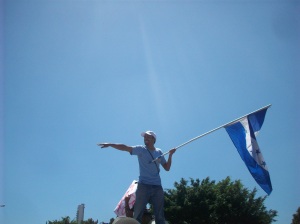
Demonstration in front of Clarion Hotel, Tegucigalpa. (Photo: Joseph Shansky)
By Joseph Shansky | Pulse Media | October 16, 2009
Since the few days of renewed excitement around the “secret” return to Honduras of democratically-elected President Manuel “Mel” Zelaya, there has been a disturbing omission of the Honduran political crisis in the international news. It would be reasonable to think that with each passing day an exiled president was camped in a foreign embassy (as Zelaya has been in the Brazilian embassy since September 21st), tensions would rise and all eyes of the world would be on that lone building. Instead the opposite has occurred and it appears as though the international press had lost interest without action to follow. The subsequent collapse and renewal (and collapse again, etc.) of ongoing “negotiations” with Roberto Micheletti’s coup government did little to breathe life into this story.
Here in Tegucigalpa, life continues under subtle siege for ordinary citizens. The city gets dark faster at night now and the people seem more frightened in general. The curfew remains. Small groups huddle together and glance around anxiously, couples hug closer, young girls grasp hands tighter and walk faster. Militia is everywhere of course, made up of young, mostly uneducated kids who twirl their guns with abandon, dig their batons into the dirt and wait for a notice for action. It can come at a whistle’s call here, and sometimes it feels as though the entire country is poised, frozen in battle.
The most recent momentous note in this political standoff occurred when Micheletti declared an impromptu State of Emergency following the massive street rallies on the day Zelaya returned. He then imposed a “decree” which stripped Hondurans of almost all basic civil liberties, including the right to assemble freely and access to media outlets which did not strictly toe the coup government line. He also imposed a continuous and rather vague curfew, allowing open interpretation for street police to constantly monitor and harass citizens. After a brief but immediate international outcry, Micheletti apologized and promised to withdraw the decree, but has done no such thing. Instead, he’s used this legal loophole to clean house by first attacking the primary ingredient of a democracy: the free press.
The studios of Radio Globo and Channel 36 were assaulted in the middle of the night and their transmitters were sabotaged and taken, thus leaving the majority of the country without access to the few independent news sources they had depended on for so long. He then forcibly evicted 55 local farm workers who had occupied the headquarters of the National Agrarian Institute for months since the June coup. According to Honduras Resists, a leading online source for Resistance support, the Institute “houses the land titles that had been attained by small rural farmers and communities through years of struggle, many of which were finally granted under the Zelaya administration, angering the powerful landholders who are responsible for the coup and now want to halt and reverse the process of land reform in Honduras.”[1]
One major effect of this curfew and the violations that it brings is that Micheletti has unwittingly drawn people to the resistance movement against the coup government who may not have otherwise been involved. The demonstrations have continued daily for four months now, sometimes taking on different forms.
An example of the varied support for Zelaya’s restoration (and against the coup in general) has been factions of the religious community. A few days ago, a group of Evangelical Christians gathered together in front of the abandoned Channel 36 television station. They planted themselves there to sing and pray for the station, for the resistance, and for Honduras. Several speeches were also made by organizers and religious figures, including priests.
When they had completed the blessing of this censored independent media outlet, they continued making the rounds, next going to Radio Globo to perform the same songs, the same prayers. It was a striking image, the Bible lying on the table next to the microphones in the studio. It conjured up big notions of God and Information and Truth and good people who believe that these ideas are not mutually exclusive.
Under the decree, the military domination has also expanded into lesser populated areas. The police have stormed neighborhoods ranging from inside the city center all the way to Greater Tegucigalpa and its outskirts. The same has happened around the country. In turn, these remote and generally much poorer neighborhoods have begun organizing independently, as they now feel the effects of constant police raids on houses and communities. These barrios, usually ignored and left to their own devices, have begun to take action.
I recently traveled one night with several other foreign journalists to a neighborhood on the outskirts of the city. Arriving amid mountains of trash, I immediately heard a cacophony of homemade percussive sounds, people drumming on whatever was freely available. We came upon hundreds of people of all ages marching in the dark together – families shouting, singing, chanting, blowing whistles, banging on nearby doors to rouse their neighbors. Along the sidelines, others watched from windows and front steps, staring fearfully and somewhat enviously at their neighbors’ courage in defying the curfew. This was just one of many similar nightly neighborhood rallies since the decree banning such gatherings.
The crowd surged up a hill and turned into an alley where a car was parked with a film projector sitting atop. After a few minutes, the organizers were able to project the image onto the side of a nearby house. The video was a compilation of homemade footage documenting many of the recent abuses their peers had suffered at the hands of the police. In one scene, the camera followed a single police officer from behind as he ran with his gun drawn directly at group of demonstrators nearby, shooting wildly and recklessly. Others showed the police randomly isolating and dragging non-violent protesters out of the street and into unmarked cars.
The images were designed to enrage the crowd, and it worked. Cries of “¡Asesinos!” (Murderers!) rang out in the night, the excitement and anger grew to a palpable climax, and for a moment I was sure that we’d soon be experiencing our own live replay of the scenes in front of us as soon as the local police took notice. These people were loud.
But aside from provocation, the video was also used as a tool to educate people who live in outlying areas to the realities of what much of the city was going through on a daily basis. It was a form of the news which had been missing from the public since Radio Globo and Channel 36 were taken off air.
This kind of sudden unity is not a novelty limited to one area of the city. The day after the decree, twenty four separate neighborhoods were listed as openly defying the curfew to protest the coup d’état. The resistance which has held steadfast for almost four months now has grown in true grassroots style. Like a domino effect, as the coup’s fear tactics increase, the opposition grows tremendously.
Regardless of what happens from the top-down politically, it would be wise to take note of the remarkable manner in which these communities have come together at ground level. On a very fundamental level, this is innovative democracy in action. Using any means possible, these citizens are courageously breaking through the information blockade that has paralyzed so much of the country and isolated much of the world from the events taking place in Honduras.
[1] http://hondurasresists.blogspot.com/2009/10/peasant-political-prisoners-declare.html
B'Tselem: Israeli soldiers vandalize, torch 8 Palestinian cars
Bethlehem - Ma’an - A string of vandalism targeting Palestinian cars by Israeli soldiers was reportedly documented by the Israeli human rights group B’Tselem.
One set of testimony recorded by the group said Israeli forces stopped a car of Palestinian workers near Hebron, evicted the men from the vehicle, told them to walk home and proceeded to break the windshield of the car and set fire to it.
In total, B’Tselem said, eight Palestinian-owned vehicles were likely torched by Israeli military personnel. A report from the group outlined details on the allegedly targeted vandalism and how they came across it.
Field workers from B’Tselem said they saw a vehicle on fire Monday, and when they stopped to investigate, met the owner of the van and his passengers, who said they had been hiding from soldiers in the fields.
The group said Hummer army jeep had chased the van, which malfunctioned and the passengers got out and ran away. The soldiers then went over to the vehicle, smashed the windows, removed the spare tires and burned them under the vehicle. The gas tank caught fire and the vehicle went up in flames, they reported.
Field workers were then approached by Israeli soldiers, identified by the Palestinian witnesses as the same soldiers who set the fire on the car, and detained the field workers for half an hour, a report from the organization said.
“The next day, five more vehicles were vandalized in the same area,” the organization announced.
Following B’Tselem requests to the Judge Advocate General's Office, two Israeli officers were suspended.
October 15, 2009
"They killed him because he was Palestinian"
 |
| Fuad's family in their home, his mother and father holding a picture of their dead son. (Hamde Abu Rahme) |
On 30 September 2009 at 11am, 17-year-old Fuad Mahmoud Nayif Turkman was standing outside his school in the village of Yabad, when he was run over by an Israeli military jeep. Yabad is located in the occupied West Bank, near the city of Jenin. An Israeli military spokesperson later claimed that "hundreds" of Palestinians were "rioting" in the area, and that the jeep had experienced "mechanical difficulties." However, eyewitnesses from the scene say that the students were doing nothing of the sort. Jody McIntyre spoke with Fuad's father, Mahmoud Turkman, and his 12-year-old brother Fadi for The Electronic Intifada:
Jody McIntyre: What was Fuad like?
Mahmoud Turkman: He was like any boy, really. Worked hard in school, popular with his friends. He was in his last year at school and was planning to go on to university. Fuad always told me wanted to finish his studies as soon as possible in order to support the family [which includes 11 brothers and sisters]. During the school holidays, Fuad would come to help me with my work building houses. Once he asked me, "Father, you work so hard all the time to give us money and put food on the table -- why do we take it so for granted?"
At home he was always on his computer -- he bought it independently, refusing to allow me to contribute anything to the cost.
Fuad was always keen on looking the part, dressing nicely and playing with his hair. I don't know if there was a girl he liked. If there was he was too shy to tell us.
Fuad was a very quiet boy; he never made problems with anyone.
JM: When was the last time you saw Fuad?
MT: The last time I spoke to Fuad, he said that he was keen to finish school so that he could get married. I told him that after your brother is released from jail [Fuad's older brother has 12 months of a six-year sentence remaining] I want to make a big party for both of you.
I once told Fuad that I was worried that my house wasn't big enough for both him and his brother, and he told me, "Don't worry, we can swap, sleeping one night each here."
A woman who lives near us recently traveled to Mecca, and when she got back she gave Fuad a necklace. She told him to wear it because she was afraid that something bad was going to happen to him -- that was two days before he was killed.
JM: Where were you when you heard the news?
MT: On the day Fuad was killed, I was trying to get permission to visit his brother in prison. Fuad's uncle called and told me that something had happened at to my son at the school, and that they were at the hospital and I should try to come as quickly as possible, but he told me that Fuad was fine. He didn't want me to face the pain alone.
When I got to the hospital, I could see that my son was in bad shape -- many tubes were stuck into his body and nose, but he was still alive.
But when I went to stroke Fuad's arms, I could feel him dying inside. I quickly recited a passage from the Quran, to ask God to take my son to heaven. The rest of the family arrived to see Fuad, but the doctors took him away to another room to perform surgery. Unfortunately, it was too late.
JM: Was anyone at the scene when he was injured?
MT: Fuad was standing on the road [of his school] with a group of friends, when the Israeli military jeep suddenly swerved left off the main road toward them. All of his friends jumped out of the way in shock, but Fuad stayed where he was -- he stuck his hands in the air and waved his arms for the jeep to stop.
It ran straight into him, reversed over his body, and then drove forward again crushing Fuad underneath for a third time. All the teachers and boys shouted for the soldiers to stop so they could help their injured friend, but the soldiers instead closed the school gate so that nobody could get to Fuad. The teachers asked the soldiers if they realized what they had just done, but they replied, "We haven't done anything wrong. This is normal."
JM: Why do you think Fuad was killed?
MT: Why? Because he is Palestinian. As the soldiers said, this is normal. The Israeli army doesn't care about the life of any Palestinian, so this can happen any time -- they can kill anyone they like. When they ran Fuad over, they didn't even look under the jeep to see what had happened, but were more interested in closing the school gate so that nobody could help him.
They then called three more jeeps for back-up, and when they drove away, the jeep rode over Fuad's body, still trapped underneath, for a fourth time! This shows their blatant disregard for the lives of Palestinian boys.
One of Fuad's brothers, also a student at the school, saw this and jumped over the school gate to help Fuad, so the soldiers started kicking him and beating him with their guns until he was bleeding from his wounds. They didn't care -- they had murdered one boy, and then they wanted to kill his brother as well.
Fuad was left alone for 40 minutes. He wasn't dead yet, but nobody was allowed forward to help. Afterwards, the soldiers told the teachers that the whole thing was an accident, but still didn't even have the decency to call an ambulance, even though they had one on call just two minutes away. Only once the soldiers thought Fuad was dead did they re-open the school gate and let the people inside go to help him.
Maybe if the soldiers had shot my son I would be able to come to terms with his death, but for it to have happened in such an undignified manner is very difficult for me to comprehend. The road he was standing on is only for the school, and is around 40 meters away from the main road, so when they swerved left so sharply, they did it because they wanted to kill someone. By the time they had run over his body so many times, Fuad's liver was lying on the pavement. My brother wrapped it in plastic so that I wouldn't have to see it.
During the second intifada, there was an accident here in Yabad where an Israeli jeep lost control and flipped over. My brother, Fuad's uncle, saw this happen and went to help them, calling an ambulance and even helping to retrieve their weapons. The soldiers had been involved in an accident, not fighting, and you help anyone in an accident. But when Fuad was lying on the ground, close to his death, and the soldiers claimed it was an accident, they had no interest in calling an ambulance. Furthermore, every Israeli military vehicle has someone who is trained in first aid, in case one of the soldiers is injured, but they refused to help Fuad. All the teachers had cars to drive Fuad to the hospital, but the soldiers prevented them from doing so.
Now, none of the students want to go back to school, because they are afraid that they will be the next victim of this occupation. All the fathers want to send their children to different schools.
JM: How has his death affected family life?
MT: In many ways! Fuad was great with the family, and got along with all of his brothers and sisters. Now, when I walk through the house and see all of his things still lying where they were -- his bed, his computer, his clothes -- I feel like he is still here with us.
Fuad's youngest brother is three years old, and he used to go to Fuad when he was on his computer and ask him to play music so he could dance to it. Every time Fuad walked through the front gate to the house, he would run to hug him. Now he always asks me, "Where is Fuad? I miss Fuad -- I want Fuad here!" I told him that Fuad has gone to heaven.
All his brothers and sisters loved him immensely, and they are so, so sad that they will never see him again.
JM: What were Fuad's political views?
MT: Fuad always told me that he thought we could make peace here in Palestine. He hated to see the fighting between Palestinians and Israelis, and desperately yearned for freedom; to be able to go anywhere he wanted, without walls or checkpoints blocking his path. He wanted peace, because it would mean that he could go to school without being afraid.
JM: What would you say to world leaders?
MT: We want peace. We need to find a solution where we live in freedom. We have a very difficult life here, and every Palestinian person is suffering. People are dying as they are held and beaten at checkpoints, children have been killed, pregnant women with their babies still in their bellies have been murdered, so the world needs to help.
JM: Fadi, how do you remember your older brother?
Fadi Turkman: I keep seeing Fuad in my dreams, playing and joking with us. I was in class at school when my teacher said to me, "Go to your house, your brother has died." I ran all the way home and when I got there I started crying.
Fuad always helped me with my school work ... in fact, we helped each other. He let me play on his computer. We went to the mosque together.
The night before he died, Fuad was here at the house playing with me and my friends.
I always used to tell Fuad everything I wanted to do when I grew up, and he promised to take me everywhere in the world.
Jody McIntyre is a journalist from the United Kingdom, currently living in the occupied West Bank village of Bilin. Jody has cerebral palsy, and travels in a wheelchair. He writes a blog for Ctrl.Alt.Shift, entitled "Life on Wheels," which can be found at www.ctrlaltshift.co.uk. He can be reached at jody.mcintyre AT gmail DOT com.
Source
October 14, 2009
Palestinian human rights activist being held without charges in indefinite solitary confinement
by Adam Horowitz on October 13, 2009

Youth holding a photo of Othman at the weekly protest against the Wall in Nil’in.
Here is an update on the case of Mohammad Othman, a Palestinian human rights activist who was detained over three weeks ago by Israel as he returned home from Norway where he had been discussing the boycott, divestment and sanction movement.
On Thursday, October 8, at the second hearing in Salem military court, the prosecution had still not been able to provide any charges against Mohammad. The judge prolonged Mohammad’s detention for a further 12 days. Addameer attorneys appealed this decision and the judge rescheduled the date for the hearing for this wednesday, 14 October 2009. The hearing is due to take place at the Military Court of Appeals in Ofer.
According to Addameer attorneys who represent Mohammad, he is still held in solitary confinement and is being interrogated daily about his trips to Europe and contacts with European organizations. Mohammad has been repeatedly cursed at during long interrogation sessions, which at times lasted from 8:00 am until midnight. However, in neither of these sessions were suspicions against Mohammad made clear to him and he still ignores the reason for his arrest. During one of these sessions, an Israeli interrogator threatened to hurt Mohammad’s sister. “Stop the Wall Campaign” contends that psychological pressure is an often used Israeli technique to coerce a detainee into confessions.
During his solitary confinement Mohammad has been held in a two-square meter windowless cell. You can follow Mohammad’s case on this website.
Also, if you’re in New York you can join Adalah-NY and the New York Campaign for the Boycott of Israel on Saturday October 17th, 1- 3 PM for a protest in support of Mohammad at Lev Leviev’s store in Manhattan. You can find more information on the protest here.
Related Post
Jaffa-based Palestinian activist facing indefinite home detention for political activitySource

